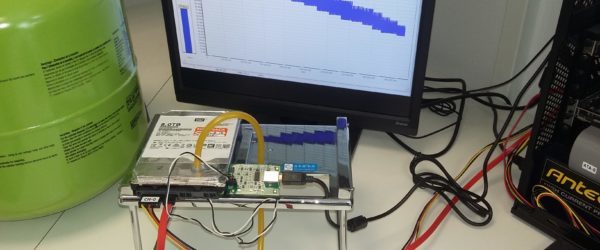Helium hard disk data recovery
Helium hard disks have pushed back the limits of magnetic hard disks in terms of storage capacity and service life. However, recovering data from this type of media is tricky, due to their design. Databack has developed solutions for working with these media.
Helium hard disks: principles and storage capacities
The development of helium hard disk drives (HDDs ) has removed a number of constraints associated with HDDs. The explosion in data volume, storage and processing had indeed come up against the limited capacities of “conventional” magnetic hard disks. Developed by manufacturers from 2013 onwards, helium storage technology was initially aimed at server rooms and data centers. Today, a helium hard disk drive can achieve a storage capacity of over 16TB, compared with just a few terabytes for an HDD.
Helium’s density is seven times lower than that of air, so this technology offers a host of improvements. Helium makes it possible to increase the number of platters inside a hard disk, thus improving its storage capacity. By improving the rotation of its platters, it reduces friction and vibration, both reducing energy consumption and extending hard disk life.
Helium-filled hard disks require a perfect seal to keep the gas inside, with double protection assembled by brazing. This tightness differentiates them from conventional hard disks, where the flow that drives the read heads comes from pre-filtered ambient air, via a small suction hole.
Our solution for data extraction from helium hard disks
Helium-cooled hard disks are not immune to failure, particularly mechanical breakdowns affecting their surfaces or read heads. However, the presence of the gas, the tightness of the enclosures and their brazed assembly pose obvious obstacles to hardware intervention.
Databack has developed an innovative solution for the secure recovery of data from helium hard disks. It has undergone many hours of research and development, guided by our expertise, before being offered to our customers. Our data recovery process has been extensively tested and validated by the normal operation of a helium hard disk following replacement of its read heads.
Removing the soldered protection to gain access to the disc’s main cover is an essential first step. The mechanical operations that follow, necessary to replace the heads, are the most conventional stage. The major difficulty lies in reinjecting the helium to put the disc back into rotation… and, above all, to re-establish and maintain the watertightness of the support!
As with all our mechanical work on damaged storage media, we carry out these operations in an ISO 5 class 100 cleanroom, in a dust-free environment.
19 February 2019









